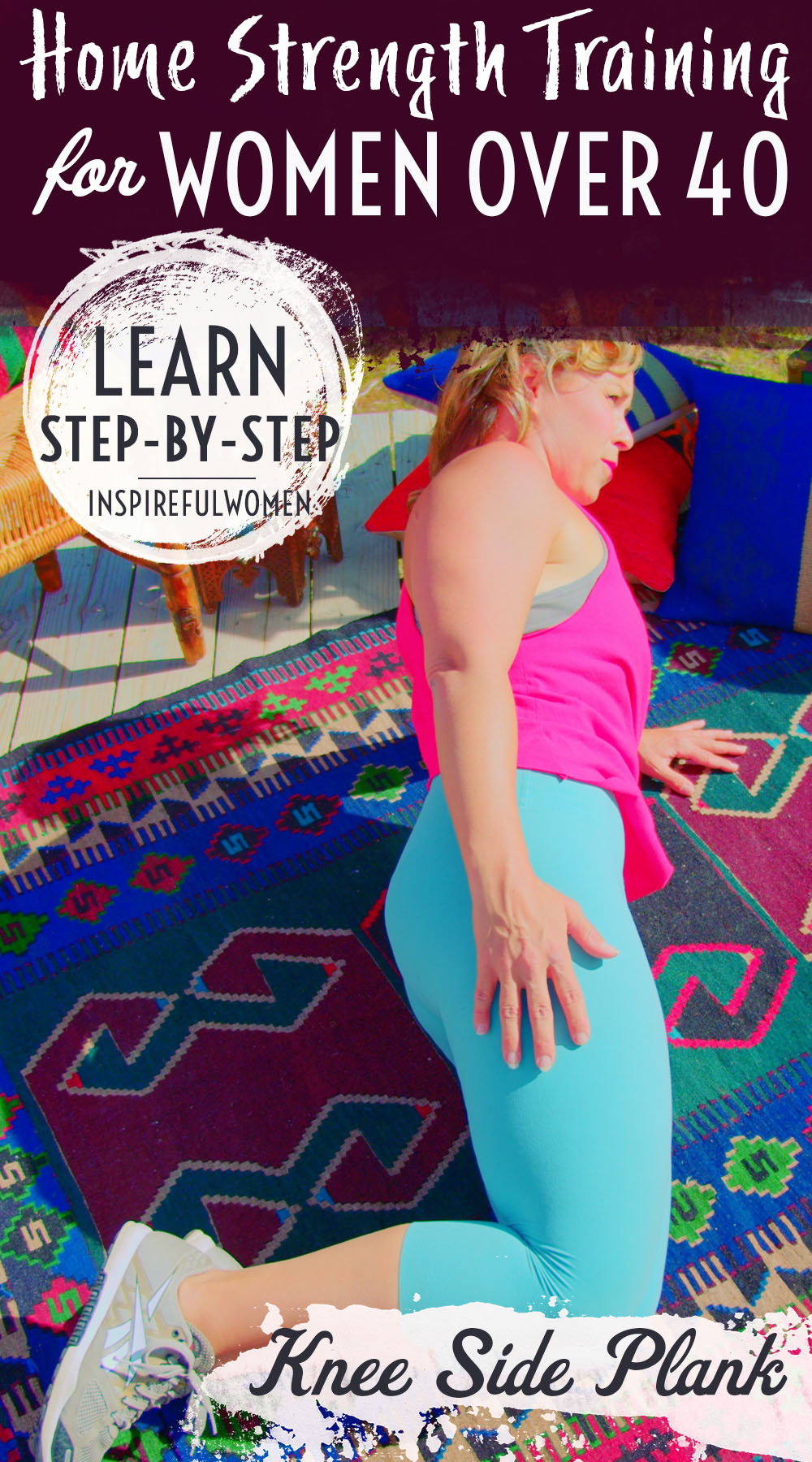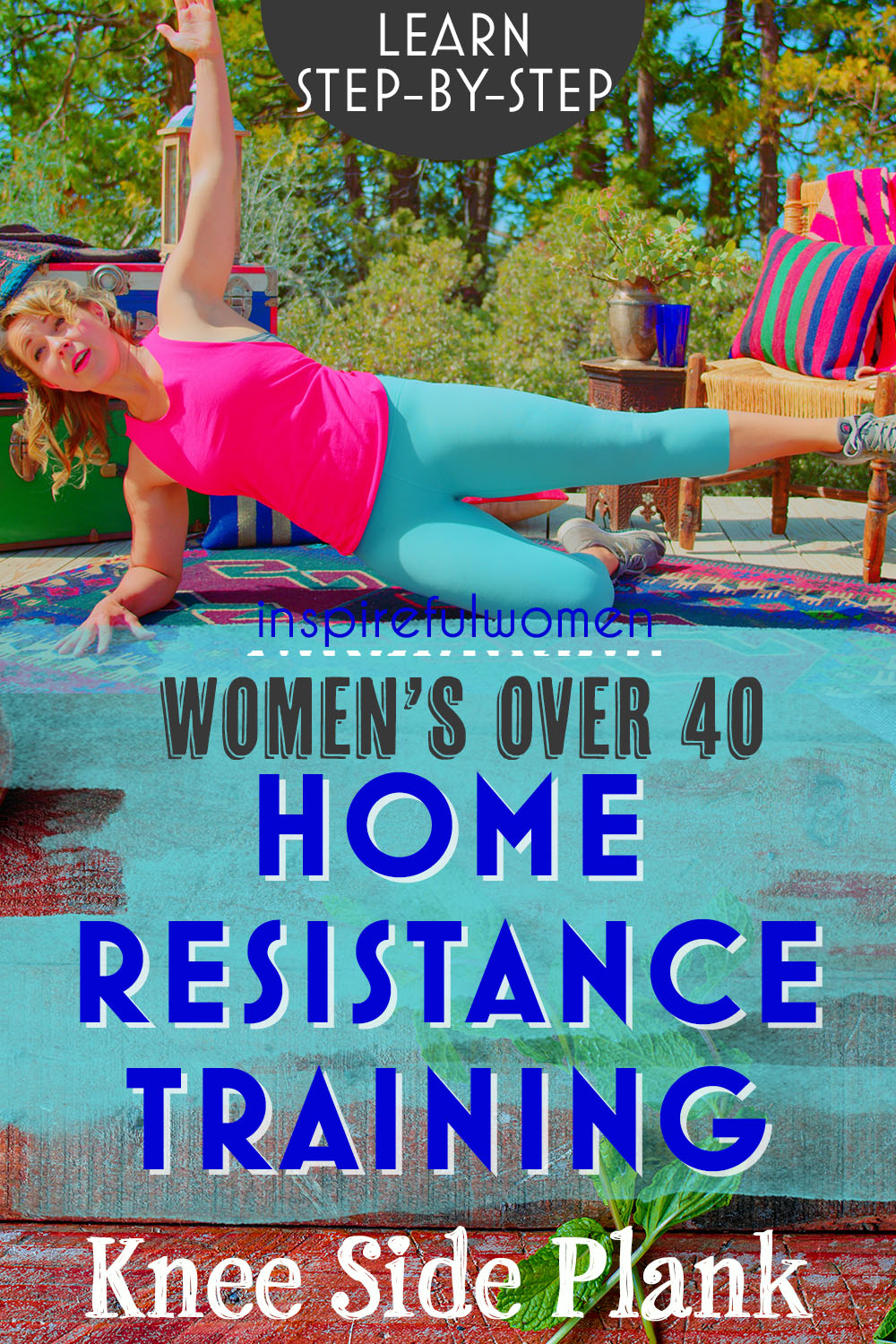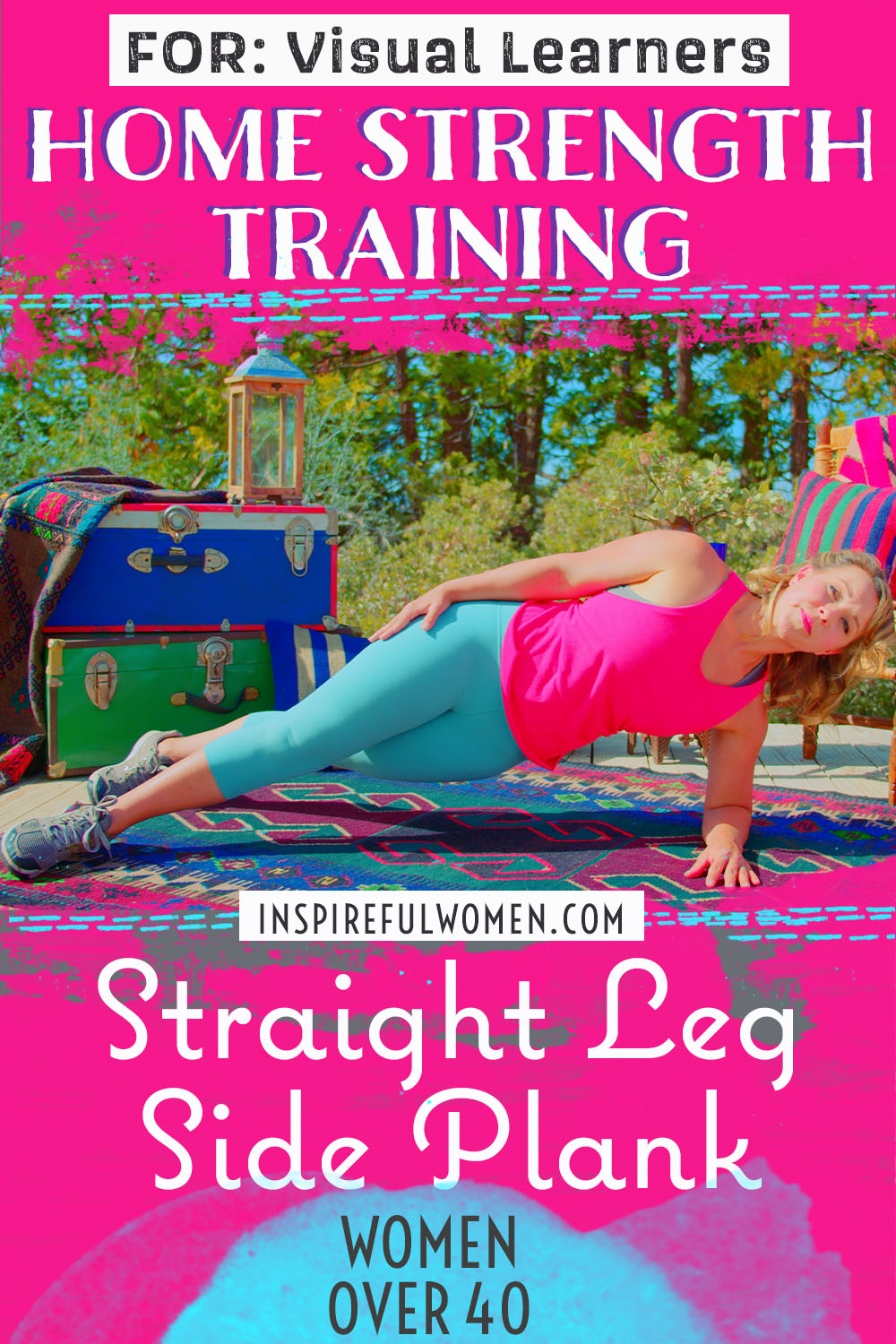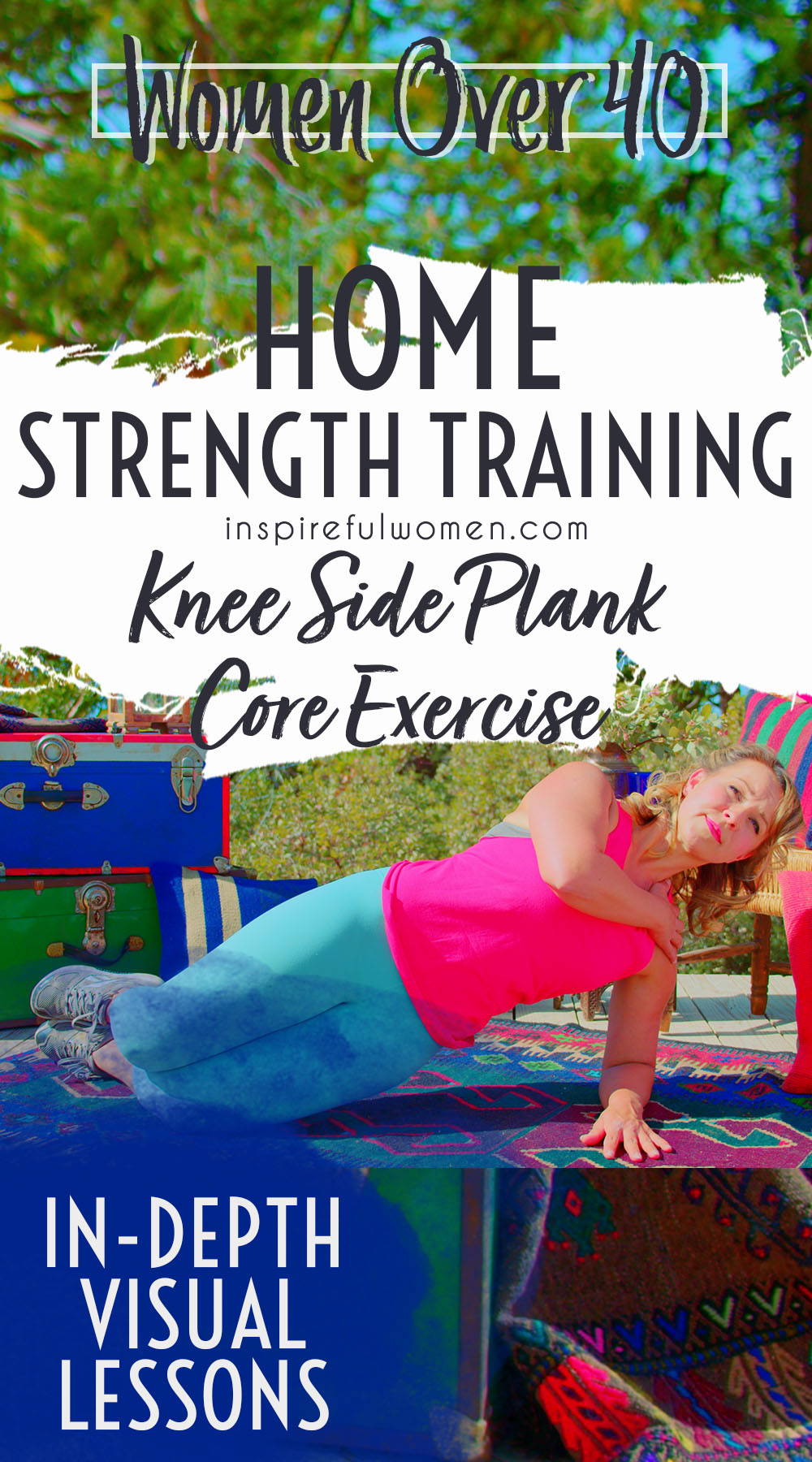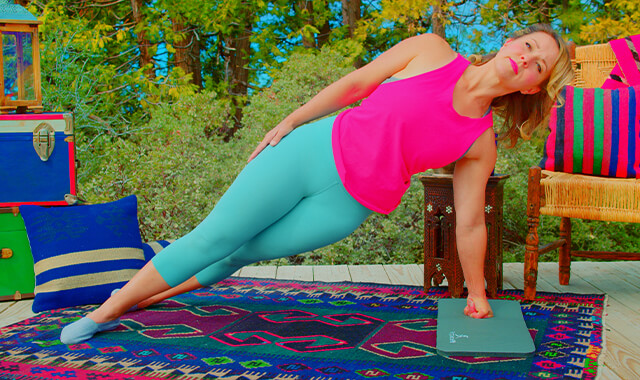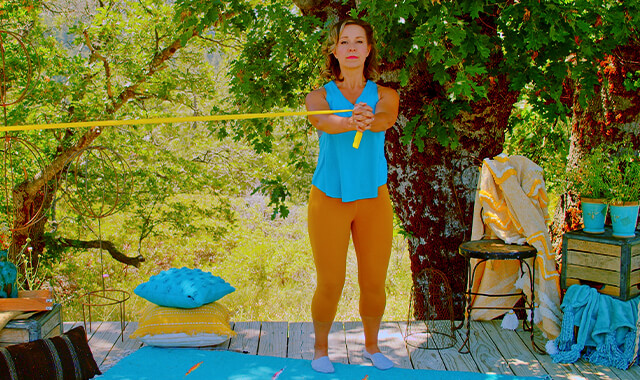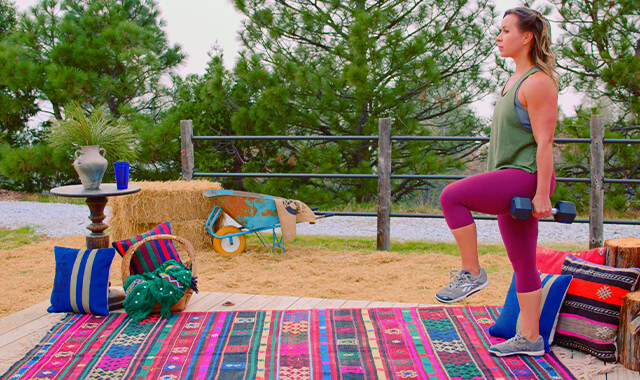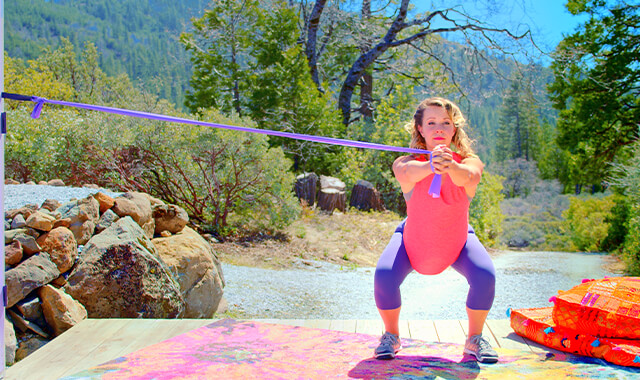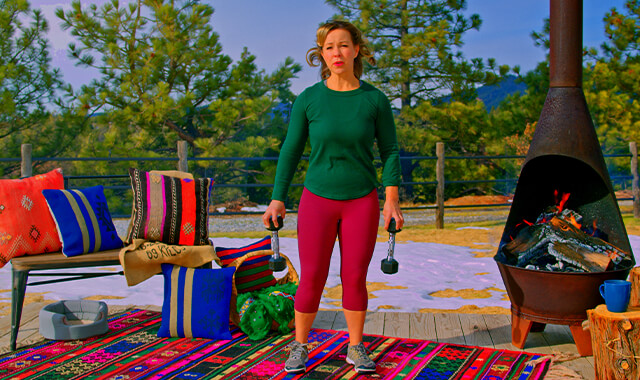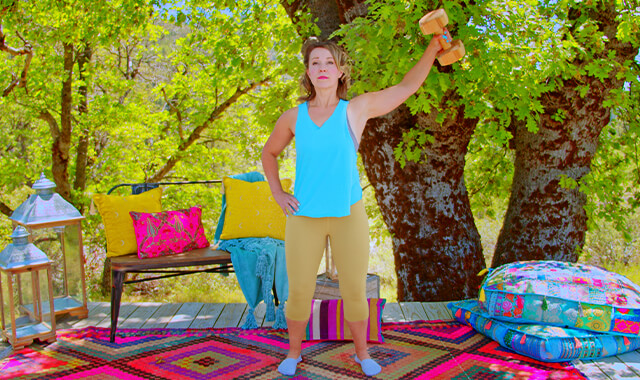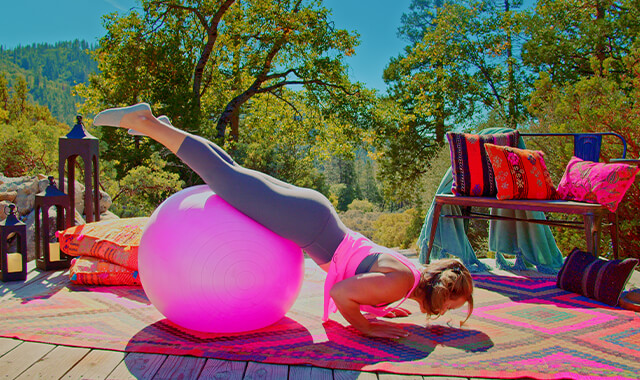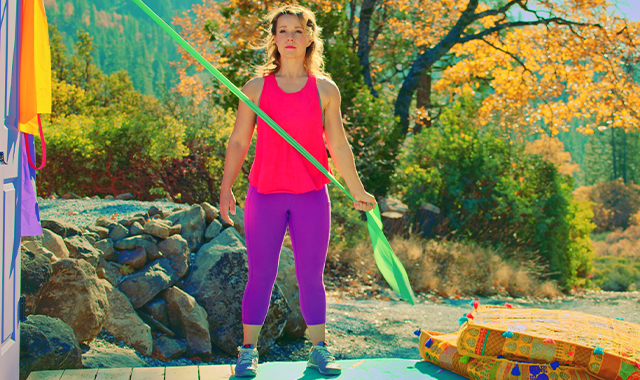Beginner Side Plank on Knees & Elbow
How to Do the Bodyweight Bent-Knee Side Plank - Floor Oblique Exercise | In-Depth Guide [VISUAL LEARNERS] Beginner
Proper Form, Common Mistakes, & Variations | Home Resistance Training
WHAT DO YOU WANT TO SEE?
QUICK DEMO
QUICK DEMO
MUSCLES THIS WORKS
MUSCLES
MAIN MUSCLES WORKED IN Side Plank on Knees & Elbow
LOTS OF CORE MUSCLES - SEE BELOW
obliques, quadratus lumborum, multifidi, transverse abdominis, latissimus dorsi, erector spinae.
OTHER MUSCLES WORKED:
- Rhomboids
- Mid and lower traps
- Rectus abdominis
- Pelvic floor
WHAT WE'RE DOING TODAY
WHAT & WHY
BENEFITS OF TRAINING THE Core muscles
WHAT
WHAT WE'RE DOING TODAY
Other names for this exercise: Side Bridge, Kneeling Side Plank, Bent Knee Side Plank
ALL WE'RE DOING:
Just a side plank on our knees & forearm. Easier.
The beginner side plank position is a very easy and effective position for training the core, lats, pelvic, and hip muscles. This exercise is done lying down on your side, just using gravity to work your muscles. This exercise doesn't require any equipment or weights at all.
The spine is positioned in neutral - no side bending or flexing of the spine. Then the hips are lifted up off of the floor. I’m going to show you a way to get into a position that I’ve learned from the Physical Therapist Tim Keeley think is a little more effective at helping us be in the right position during the exercise than what I commonly see taught online.
GETTING INTO POSITION BY MOVING FORWARD, NOT UP
This is going to seem counterintuitive because we know that a plank involves our body rising vertically in the air. The regular way most of us were taught to get into position for a plank involves bending at our sides to hoist ourselves vertically up into position.
But after seeing some really good info from physical therapists, the best way to get into position is actually to start in a tipped-over bottom-of-the-squat type position & push our hips FORWARD, rather than up. This will still get us into the right place we need to be but with a higher likelihood that our body parts are in a good position to work the correct muscles.
The best way to get into the side plank position is to start with the knees in front of the torso. Using the gluteus maximus, the hips are pushed forward, like a side-lying bridge (or even like the movement at the hips when you come up from a squat or hip thrust), to straighten the front of the hips and lift your pelvis up off of the floor. So rather than thinking of lifting up vertically, which is what I think we’d all naturally do, we’re actually moving our hips forward.
It is easier to keep your spine in a neutral position when you get into a side plank this way and it ensures that you are using your gluteal muscles to hold the position (not your hip flexors). From Carol: Most people lie on their sides with their hips in a flexed position, then push up into the side plank, they keep their hips in flexion instead of neutral. And if they realize their hips are flexed once in the plank, it is very hard to adjust to correct.
Doing the side plank on the forearm and from the knees is the basic version. Once you are able to hold the position nice and steady for at least 20 seconds, the exercise can be progressed to increase the challenge. There are many different variations you can try once you have mastered the side plank. Extending the legs out, and using a straight arm instead of the forearm will make the exercise quite a bit more challenging. Many leg lift exercises and arm movements can be done in this position.
WHY BOTHER DOING IT?
WHY
WHY DO WE EVEN CARE?
HEALTHIER WAY TO WORK THE SIDES OF OUR CORE
The side planks are good for working the muscles on the side of the torso, the obliques and quadratus lumborum. Many people think that you have to do exercises that involve twisting the trunk back and forth, like Russian Twists, to target these muscles. The problem with those exercises is that they could make the lower back unstable instead of strengthening the muscles to make it more stable. Rotating one section of the spine over and over again can stretch out the supporting structures, and over time cause too much motion in that section of the spine. This excessive motion can result in damage to the joints, nerves and ligaments.
The safest way to work the core muscles is to
1. hold the spine in neutral
2. against an outside force trying to pull the spine out of neutral.
That could be a band pulling at your, or in this case the outside force is gravity.
When you lie on your side and suspend your midsection above the floor, gravity will be pulling it down. The obliques and quadratus lumborum along with all of the other muscles of the core, will have to work to hold the spine in neutral.
The greater the distance between the two anchor points of the body, the greater the force pulling down. For the side plank - the easiest position would be the knees anchored on one end and the forearm on the other end. Extending the legs out would lengthen the distance between the two anchor points and the muscles would have to work harder.
TRAINS SPINAL STABILITY WHICH = A FEELING OF A STRONG CORE
Core “strengthening” is more about training the muscles how and when to respond as opposed to growing muscle. Many people that injure their backs have strong back and abdominal muscles with a well formed 6-pack appearance, but ironically, they have poor spinal stability. What exactly is spinal stability? It is basically using the muscles to stiffen the spine to prevent the spine from moving under a load. If you want to be able to lift, pull, push or carry something, first the spine has to be “stiffened”. Imagine trying to use a shovel with a flexible handle. You would not be able to pick much up with it. That is the same idea as the spine. The spine is flexible to allow movement but if you want to pick something up the muscles need to support and stiffen the spine. In order to do this, the muscles work together in coordination, like a well orchestrated symphony - each muscle is trained to do its job, knowing exactly when to contract, how much to contract and when to relax. When the core muscles work correctly - it is like wearing one of those back braces you see people wear when they do heavy lifting. The muscles surround and support the spine, stiffening it up so you can lift more weight without damaging the spine.
LOW COMPRESSION POSITION - GOOD IF YOUR BACK IS FEELING SORE OR TIGHT
One of the benefits of working the core muscles in the side lying position is that there is less compression of the spine. When you are standing up there is compression on the disks of the spine because gravity is pulling the vertebrae straight down, pulling the vertebrae closer together and compressing the disks (there is one disk between every two vertebrae). When you lie on your side there is less compression on the discs. The side plank can be very effective for targeting the core muscles while minimizing compression of the spine. This is a nice option if you have been doing a lot of loaded spine exercises or if your back feels sore or tight.
GLUTE MEDIUS BONUS WORK
Another benefit of working the core muscles in this position is that you are activating the muscles on the side of the hip that help support the pelvis at the same time - the gluteus medius. The movement of the pelvis and back are interconnected - the movement of one area will affect the movement of the other. It is important to train the muscles that stabilize the pelvis to work in coordination with the muscles that stabilize the spine.
EVERYDAY LIFE
EVERYDAY LIFE &
MUSCLE FUNCTION
HOW WE USE OUR Core MUSCLES IN EVERYDAY LIFE
1. ALL OF THE MUSCLES OF THE CORE WORK TOGETHER TO STABILIZE THE SPINE. THE OBLIQUES AND QUADRATUS LUMBORUM ARE PARTICULARLY IMPORTANT FOR HOLDING THE SPINE STABLE DURING:
Rotation of the torso:
- Swinging a golf club or tennis racket
- Loading/unloading the dishwasher
- Shoveling
- Vacuuming
- Mopping
- Raking
STARTING POINTERS
Starting Pointers
This is the basic side plank position. This movement is good for feeling the obliques and gluteus medius working, and for those with any history of pelvic, or low back pain, or difficulty activating your gluteus maximus. Getting into the side plank from a bent knee position uses the gluteus maximus to help lift the pelvis off of the floor by straightening at the hips, similar to a bridge or hip hinge movement. It is the easiest version and the best way to learn the correct form before moving on to more advanced variations. Once you are able to hold this position for at least 20 seconds with good form you can progress to the straight legs and straight arm, or adding resistance with arm or leg movement versions.
HOW TO DO THE EXERCISE
LOOKS
HOW Side Planks on Knees & Elbow SHAPE OUR BODY
Trim waist, upright posture, strong, graceful movement.
PROPER FORM
PROPER FORM: Side Plank on Knees & Elbow
EQUIPMENT, SETS & REPS
EQUIPMENT
None
SUGGESTED STARTING WEIGHT FOR WOMEN:
None
SETS & REPS:
3 reps to fatigue
PACE:
Static hold, monitor form while in the position.
BODY POSITION
BODY POSITION FOR THE Side Plank on Knees & Elbow
BODY STANCE: Lie on your side, knees bent. Sternum lifted shoulder blades in and down your back. Lift the side of your waist up so both sides are equal (hips are still on the floor).
LEGS: Feet and knees together. Knees will be in front of your body - hips bent forward - your thighs about halfway from being perpendicular (like a lap) and being straight down in line with your hips.
ARMS: Bottom arm - elbow bent with your forearm on the floor. Your forearm is out in front of you - perpendicular to your torso. Elbow under shoulder. Hand can be flat on the floor or in a relaxed fist - whatever is most comfortable. Top arm, elbow bent upper arm tucked to the torso, you can rest your hand on your chest, or lying along the side of your torso, or your hand on the top of your pelvis, or whatever is most comfortable. Putting your hand of the top on your opposite shoulder and pulling your elbow down towards your pelvis can help to activate your lats.
HEAD: Looking straight ahead, neutral - not side bending.
HOW TO DO
HOW TO DO Bent Knee Side Plank
CUE: Concentrate on keeping your spine neutral as you press up. Thinking about pulling both shoulder blades down towards your pelvis can help to activate your lats - which helps to stabilize your torso.
With your bottom arm, push down into the floor to lift your hips off of the floor. Push your hips forward - straightening the front of your thighs - like a side-lying bridge - or like pushing up from a squat or into a hip thrust. You will be using your glutes (hip extension) to lift your hips forward.
Try to relax your neck and lower legs. Engage your core muscles by gently drawing your belly button inward, while breathing normally.
You should be able to draw a straight line (from the front) through your head, torso, and belly button. From the top - earlobe, shoulder, hip, and knees.
Starting at your head, do a body scan, checking for proper alignment and muscle activation.
Continue to scan your body moving from head to toe continuously until you are not able to hold the correct positioning.
The limiting factor for how long you can hold the position may be anywhere along the length of your body - frequently the small neck muscles.
Bend at your hips as you lower your pelvis back to the floor.
Take a break, get back into position, and continue for the desired number of reps.
HOW TO SAFELY GET OUT OF THE EXERCISE
Bend at your hips and lower your pelvis to the floor, roll to your stomach, push back with your hands to kneeling. Step to standing.
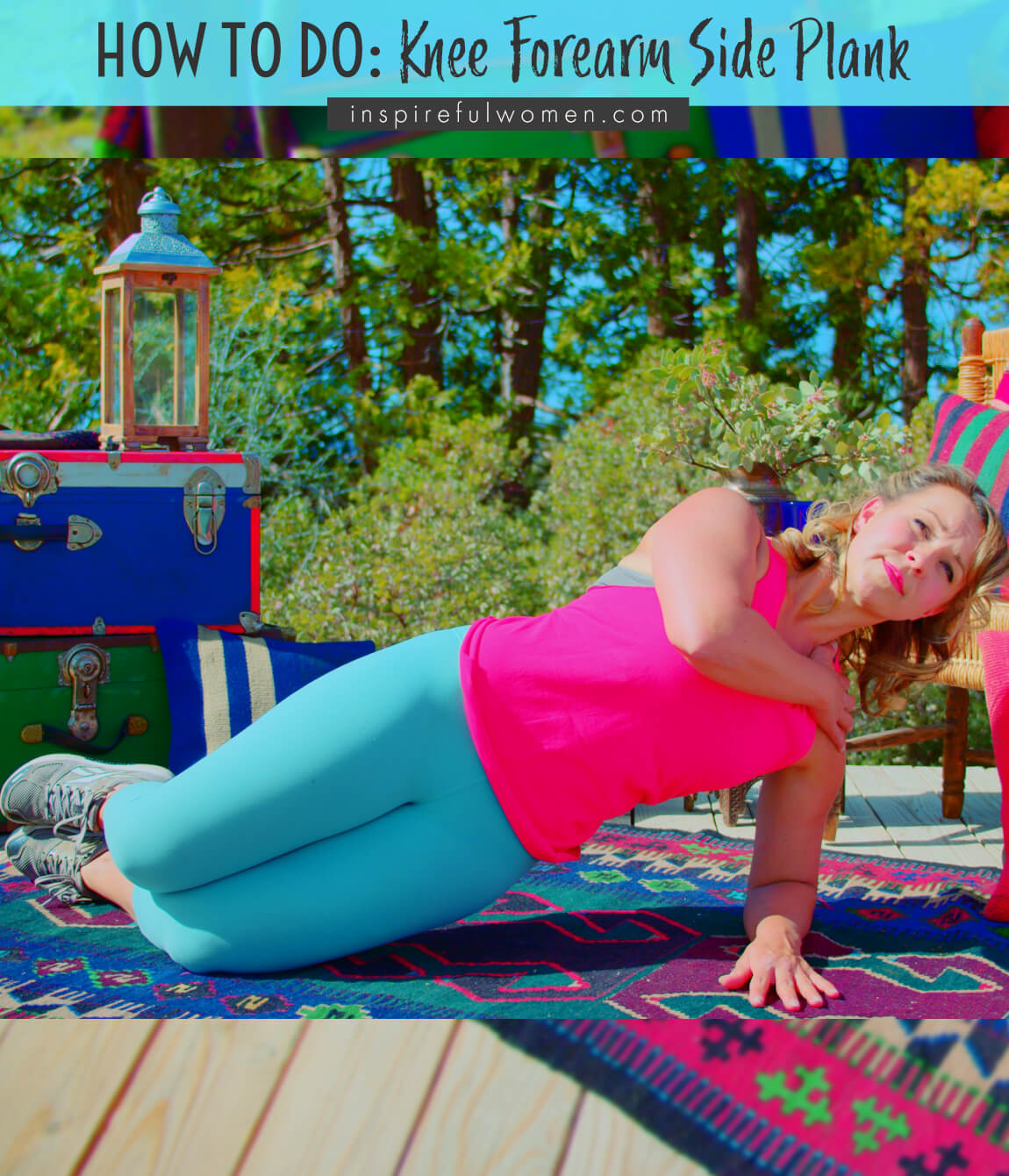
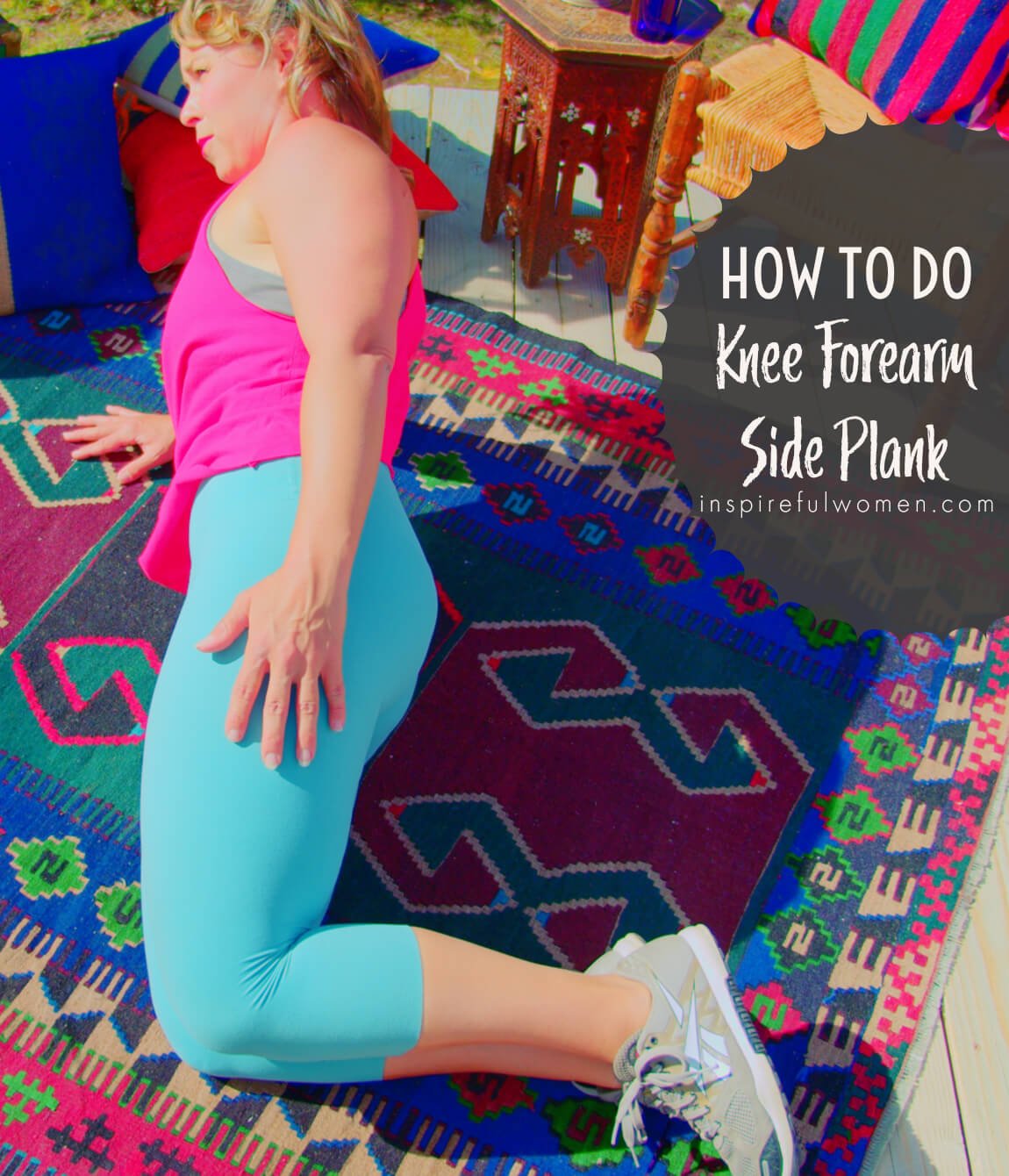
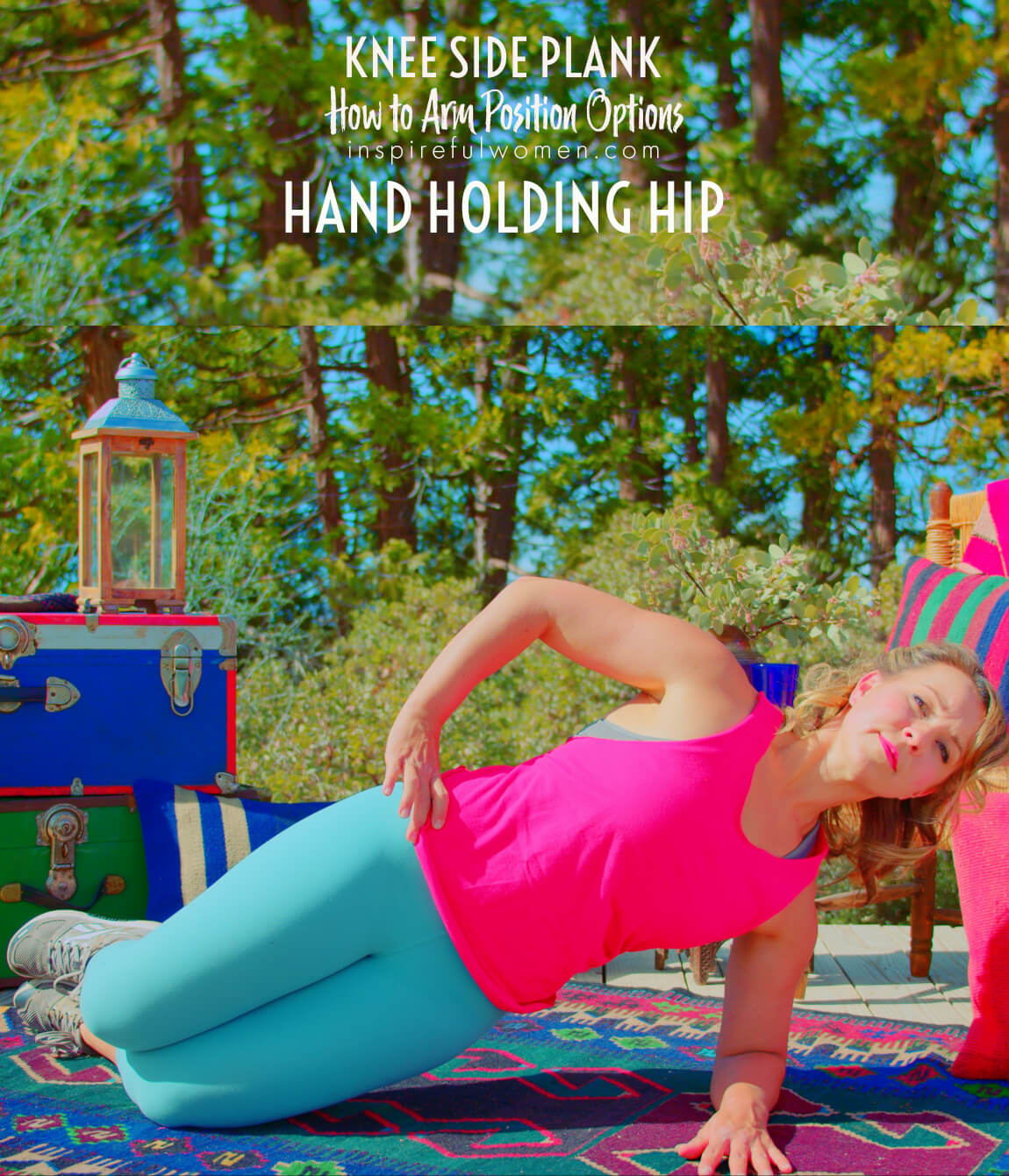

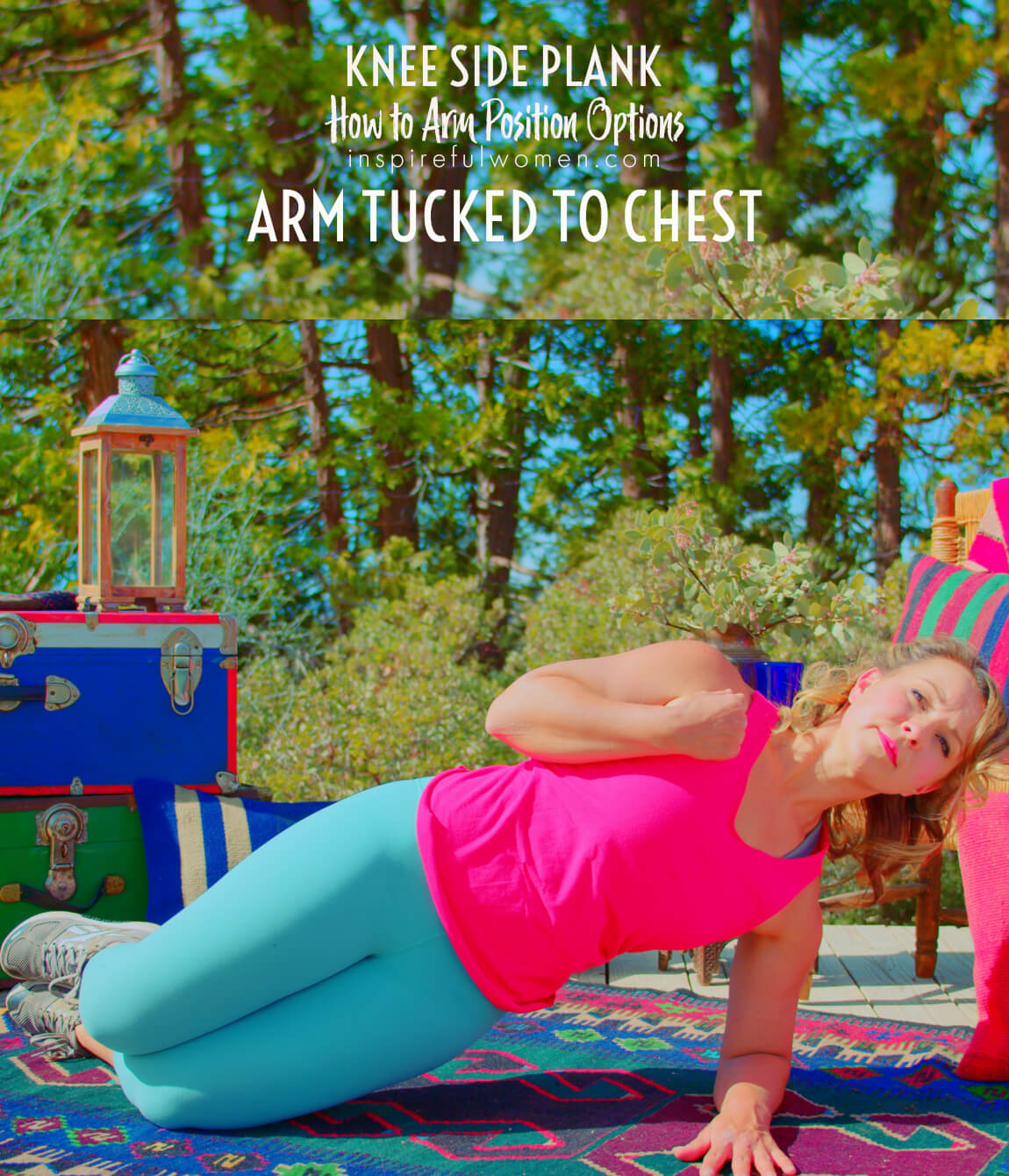
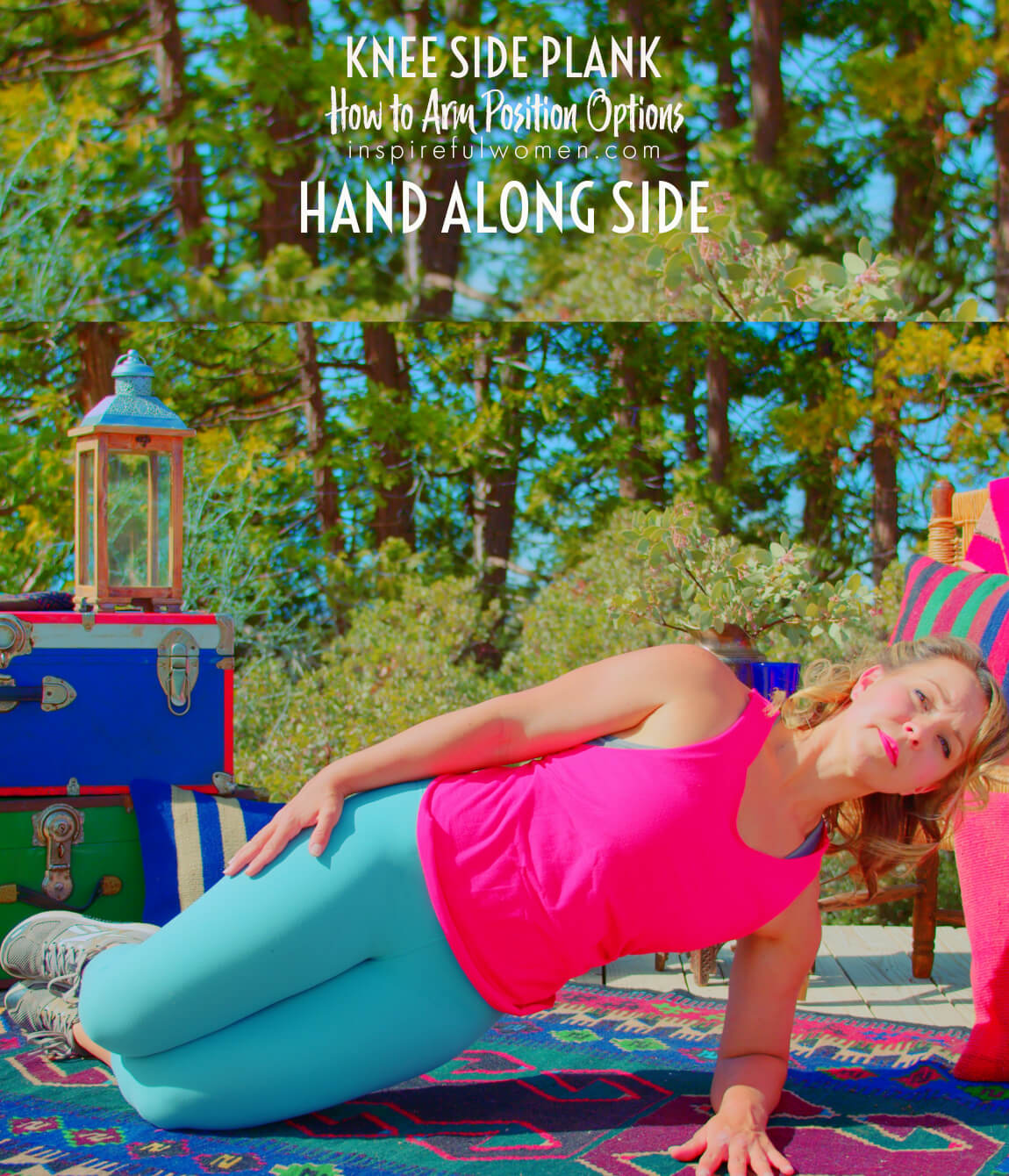
COMMON MISTAKES
COMMON MISTAKES
WHAT TO AVOID WITH THE Side Plank on Knees & Elbow
KEY TIP:
Guess what? Good news! Many avoids are the same for most movements. Once you learn the basics, there's really only a few extra avoids for each individual movement.
1. Avoid midsection sag
AVOID: Letting the pelvis or midsection sag.
WHY NOT?
- This can pull your low back out of the neutral position and can lead to injury or muscle strain.
WHAT TO DO:
- The sides of the waist should be equal.
- Activate the hip abductors of the bottom leg to push the pelvis to a level position.
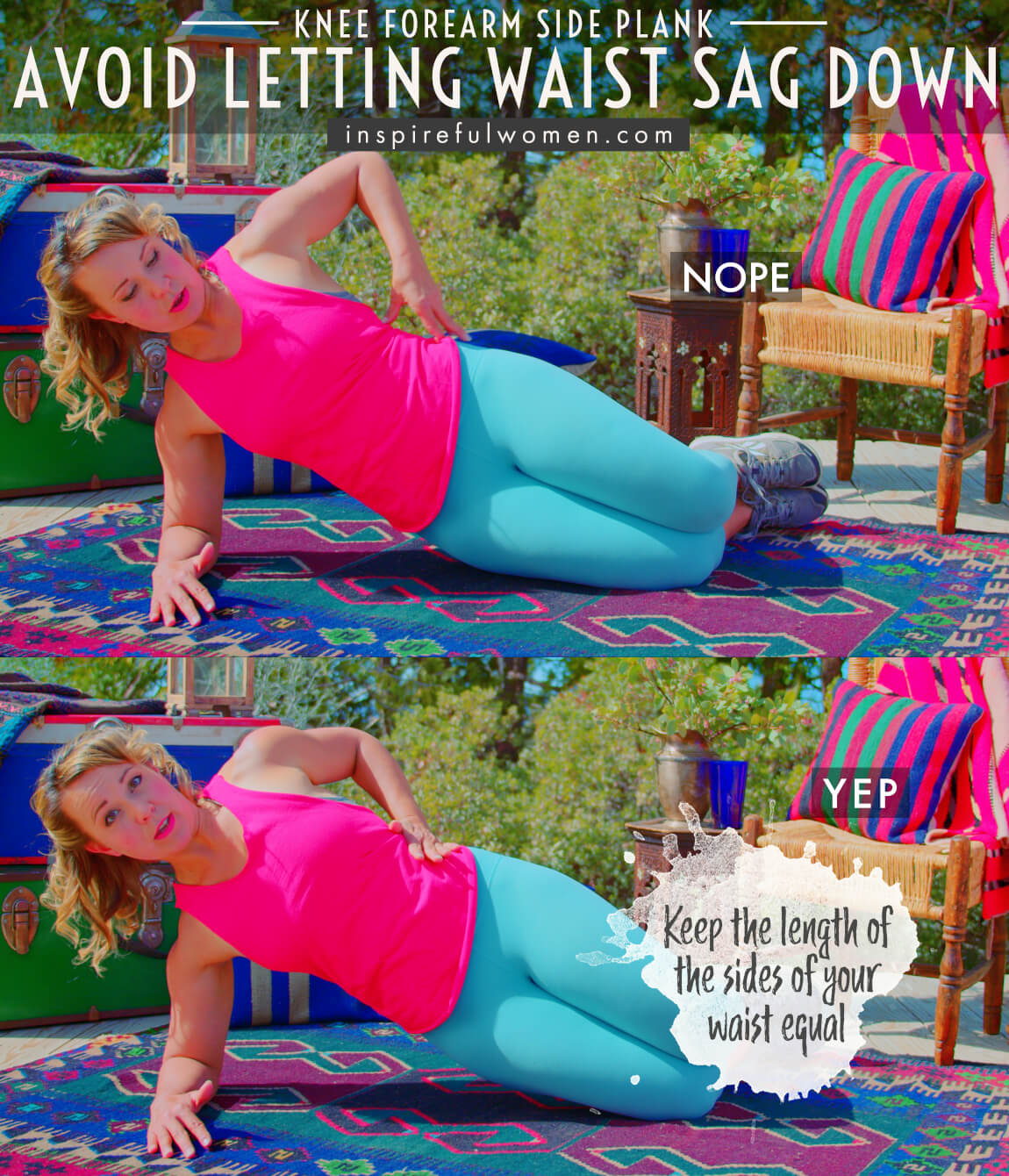
2. Avoid dropping into shoulder
AVOID: Dropping into the shoulder or letting the shoulder rise up towards the earlobe.
WHY NOT?
- Stresses the shoulder joints, increases the lumbar curve.
WHAT TO DO:
- Keep the shoulders back and sternum lifted and the shoulder blade depressed.
- Press down into the floor with the support hand.
- Lengthen the spine (includes neck) and energize the arm that is reaching out.
- This will activate the muscles of the core.

3. Avoid lifting hips
AVOID: Lifting the hips up into the air too high.
WHY NOT?
- This means you are side-bending the spine.
- It will decrease the activity of the obliques and quadratus lumborum.
WHAT TO DO:
- The goal is to work the muscles in a neutral spine position.
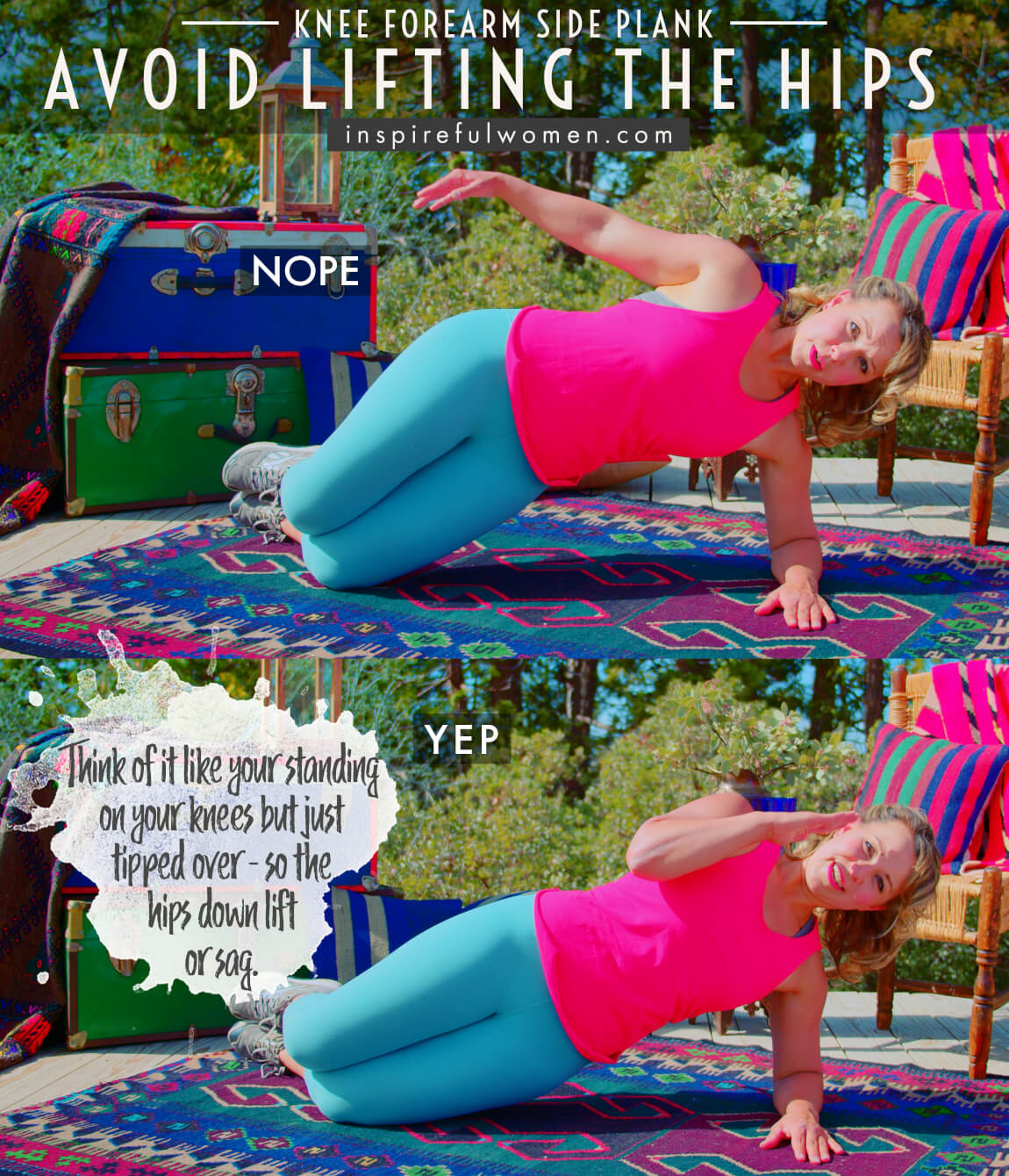
4. Avoid hip shoulder rotation
AVOID: Letting your hips or shoulders rotate/ lean forward or backward.
WHY NOT?
- This means that your spine is rotating.
- This defeats the purpose of the exercise.
- The goal of the exercise is to activate the muscles of the torso to train the muscles to hold the spine in a neutral position.
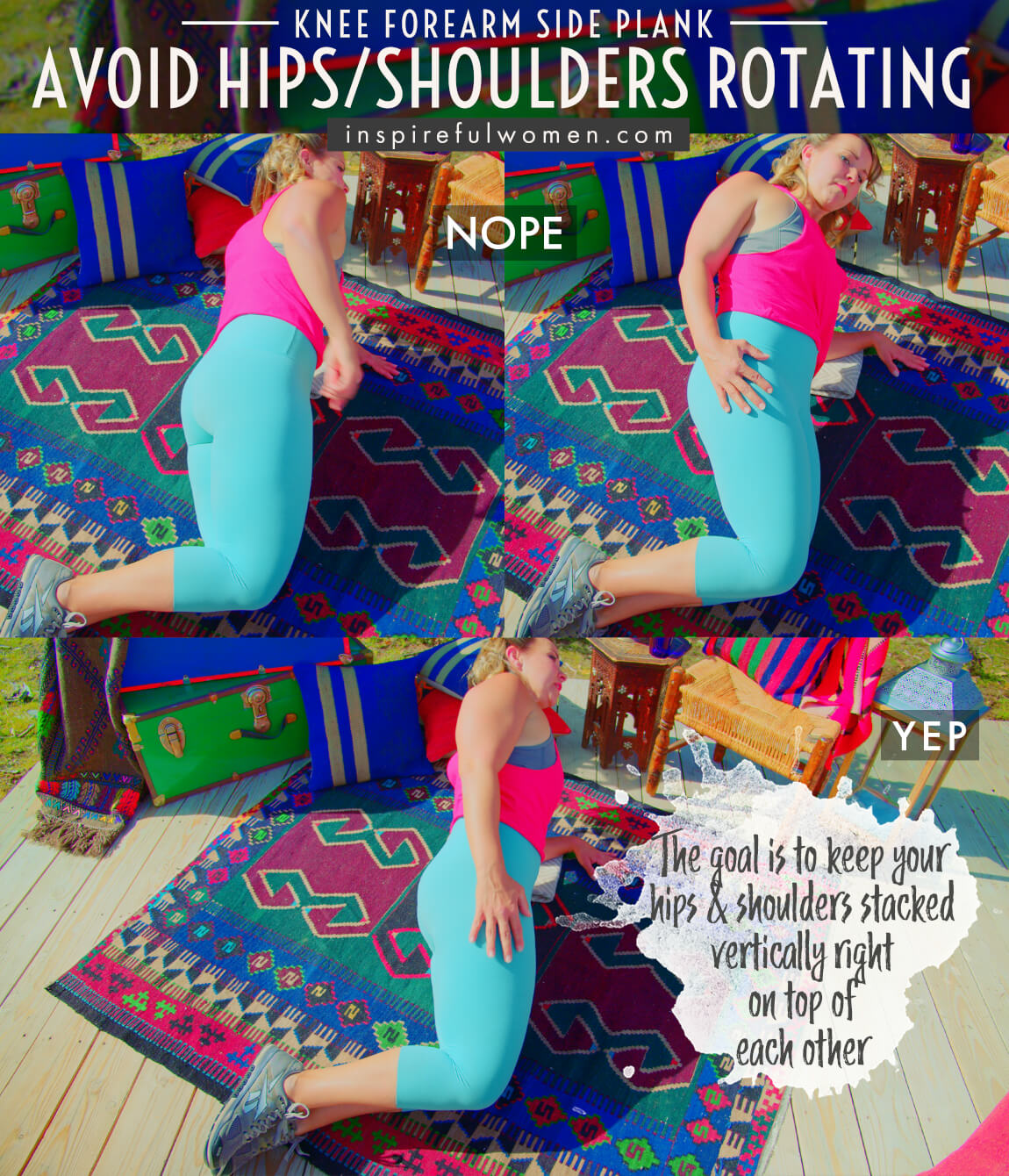
5. Avoid bent hips
AVOID: Bending at the hips.
WHY NOT?
- This is a common cheat that will make the exercise much easier.
- This happens when you use your hip flexors to hold you up.
- This defeats the purpose of the exercise - using the hip flexors instead of the core muscles.
WHAT TO DO:
- Keep a straight line from earlobe to feet - it is helpful to use a mirror, or take a video to look at your form.
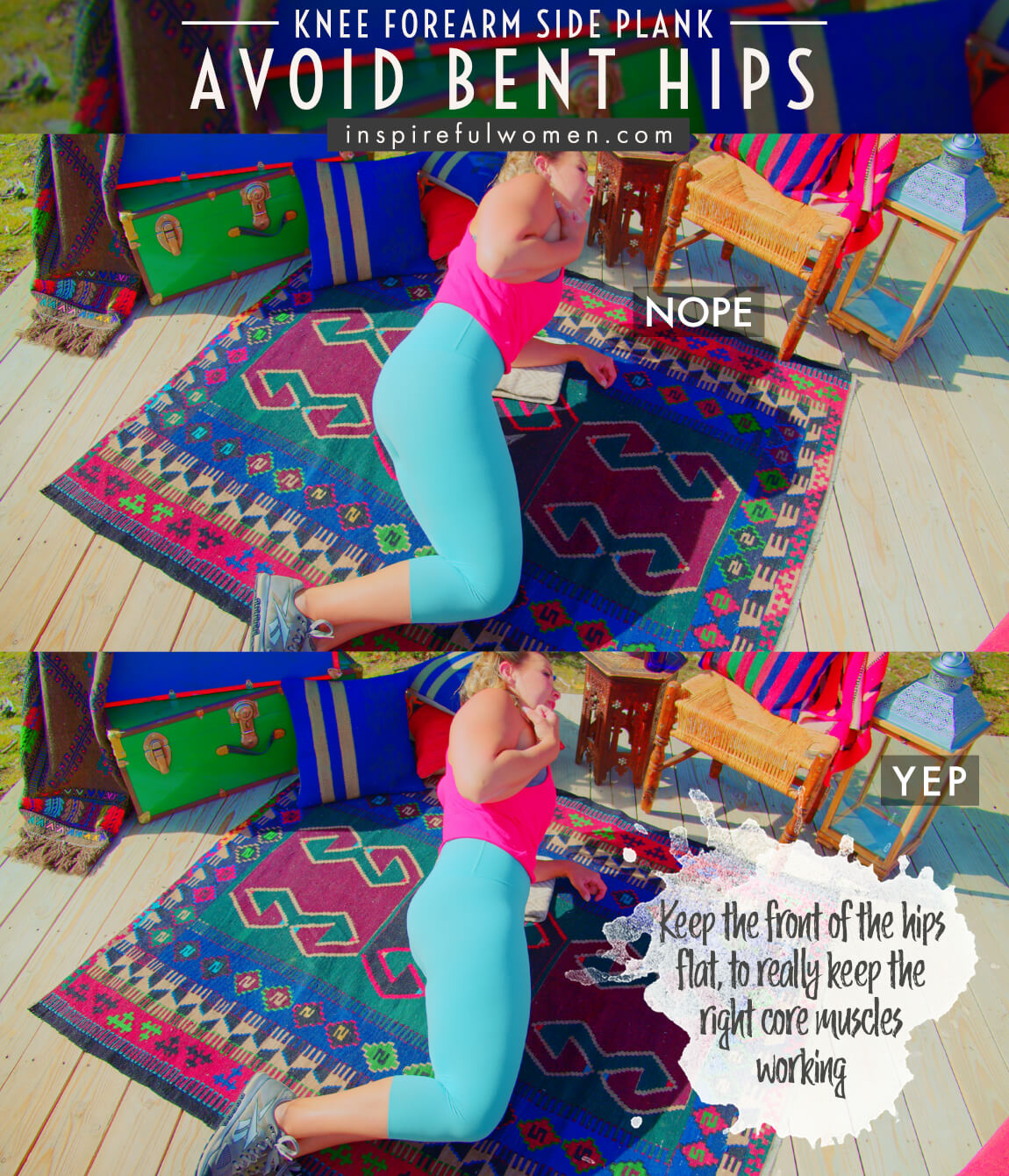
6. Avoid elbow not under shoulder
AVOID: Elbow not under shoulder.
WHY NOT?
- Poor alignment can be stressful on the wrists, elbows and shoulders.
WHAT TO DO:
- Make sure that your elbows are directly below your shoulders.
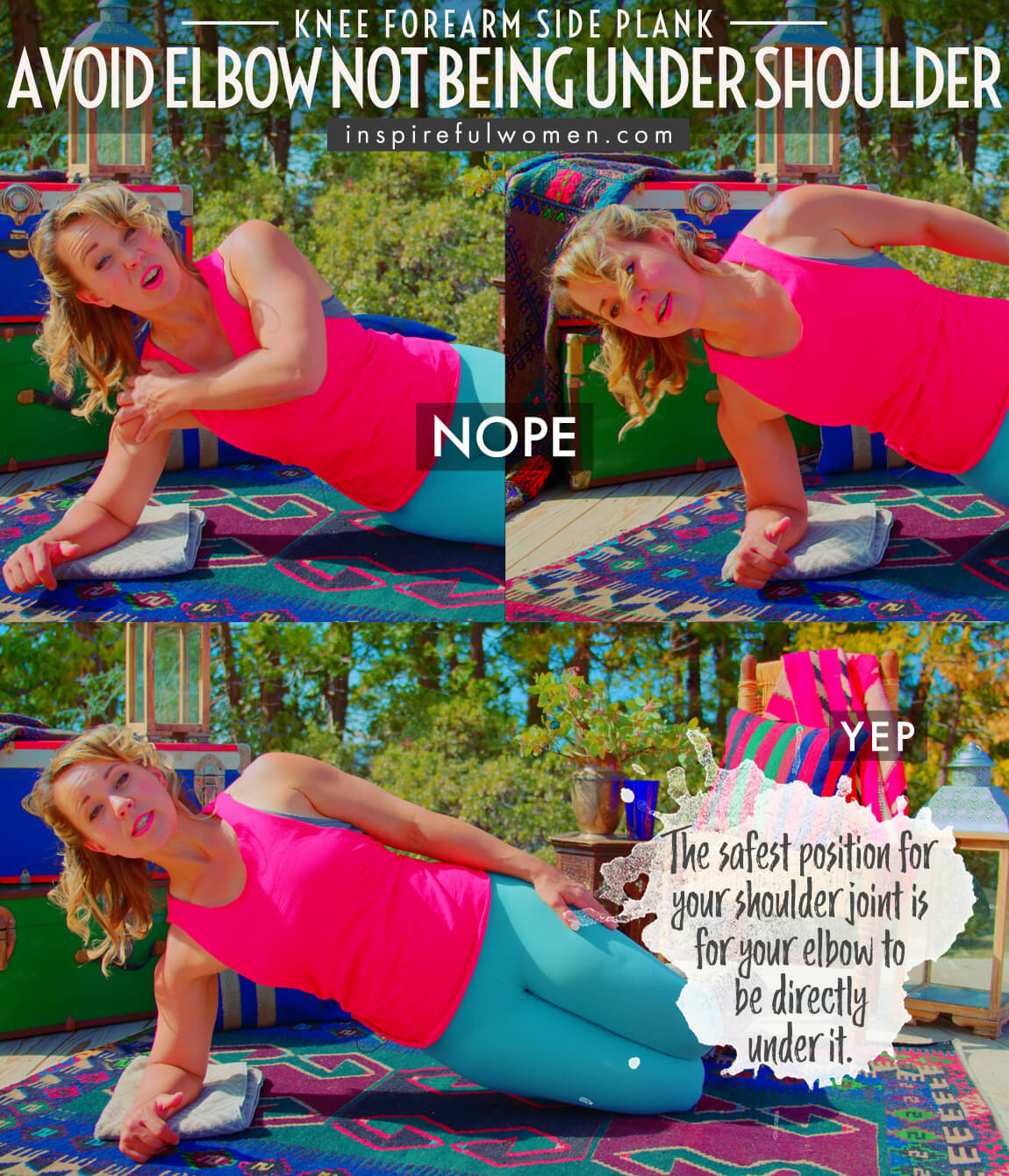
VARIATIONS
VARIATIONS
VARIATIONS OF Side Plank on Knees & Elbow
arm in air
arm in air
Lift the top arm up. You can just hold it straight up which will make it harder to stay stable, or you can lift it up so that it is parallel with the floor and move the arm forward (shoulder flexion) and back - either to the torso or even behind the torso. You can also try the side-lying plank rows.
add arm movement
add arm movement
These can be done without weights or holding a small dumbbell - 1-5 pounds. The core muscles will need to work harder to keep the body still in the side plank position. You will also have the benefit of resistance training for the top arm.
Options:
TOP ARM: Lift the top arm up into a T position and hold.
ARM CIRCLES: Lift the arm up off of the torso and draw a circle - this can be a small circle, or for more challenge, a larger circle.
ARM LIFTS (ABDUCTION): Lift the top arm up off of the side of the torso. This is like a lateral raise - the supraspinatus will do most of the work to initiate the movement and then the lateral deltoid will work most when the arm is parallel with the floor. As the arm is lifted higher the shoulder muscles will not work as hard but the core muscles will have to work harder (the weight is moving further from the body).
ARM FORWARD AND BACKWARDS: Lift the arm up so that it is parallel with the body and move it forward (flexion) and back behind the body (extension). Most of the work in the shoulder muscles will be from the rotator cuff and the lateral deltoid. The core muscles will need to stabilize against the moving weight.
straighten top leg
straighten top leg
staggered straight legs
staggered straight legs
Stagger the feet with the bottom leg at a slight angle in front of you (a slight hip crease) and the top leg in front of the bottom leg. The sides of the feet are resting on the floor - the outside of the bottom foot and the inside of the top foot. Push down into the feet and forearm, keeping the knees straight, as you push the hips forward and up - the hip crease in the front of the bottom leg should be straight at the top of the movement.
narrower stance staggered legs
narrower stance staggered legs
Staggering the feet - with both feet on the floor - one in front of the other will be more stable and will be easier.
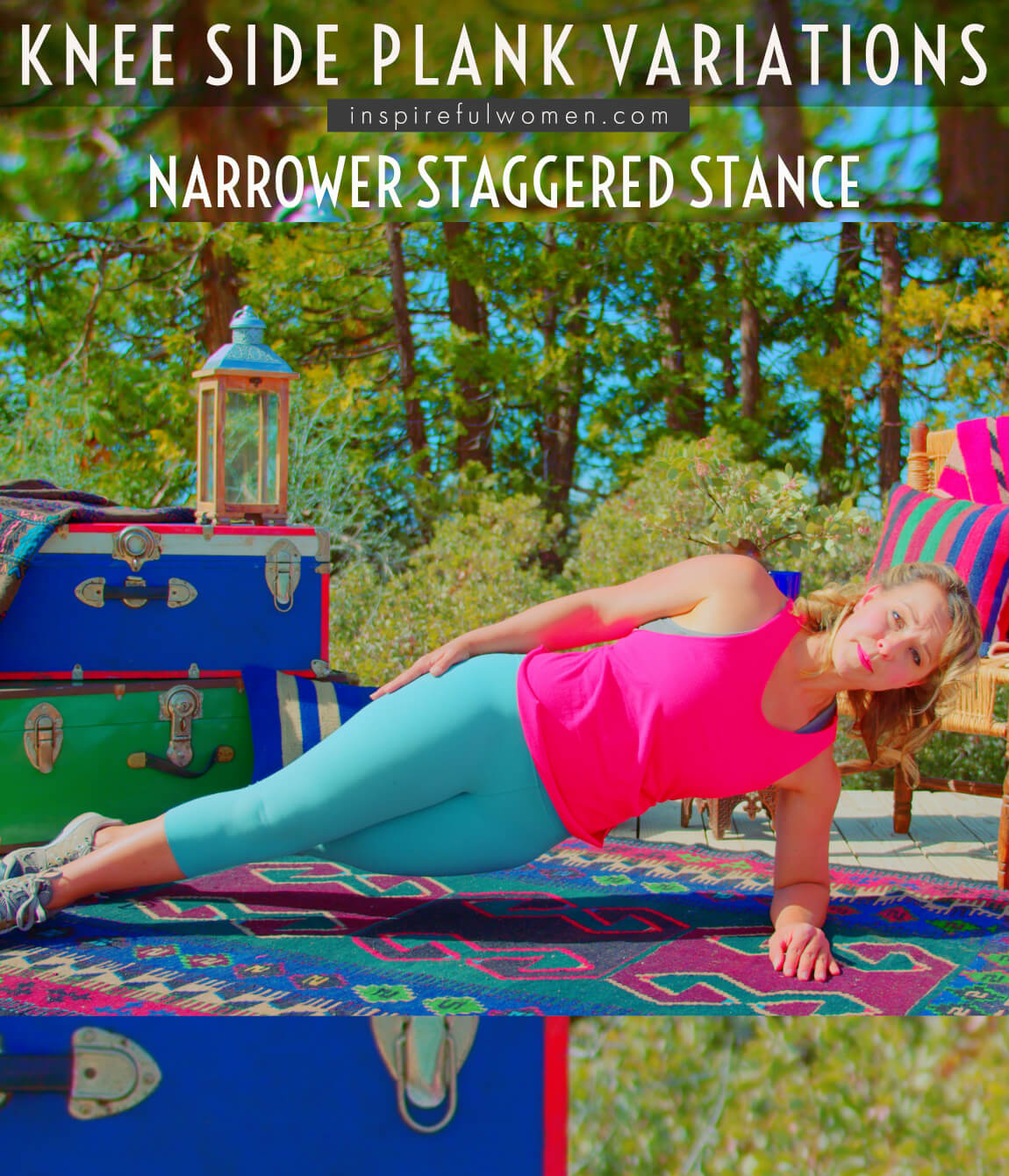
stacked feet
stacked feet
Stacking the feet one on top of the other will be less stable and harder to do.

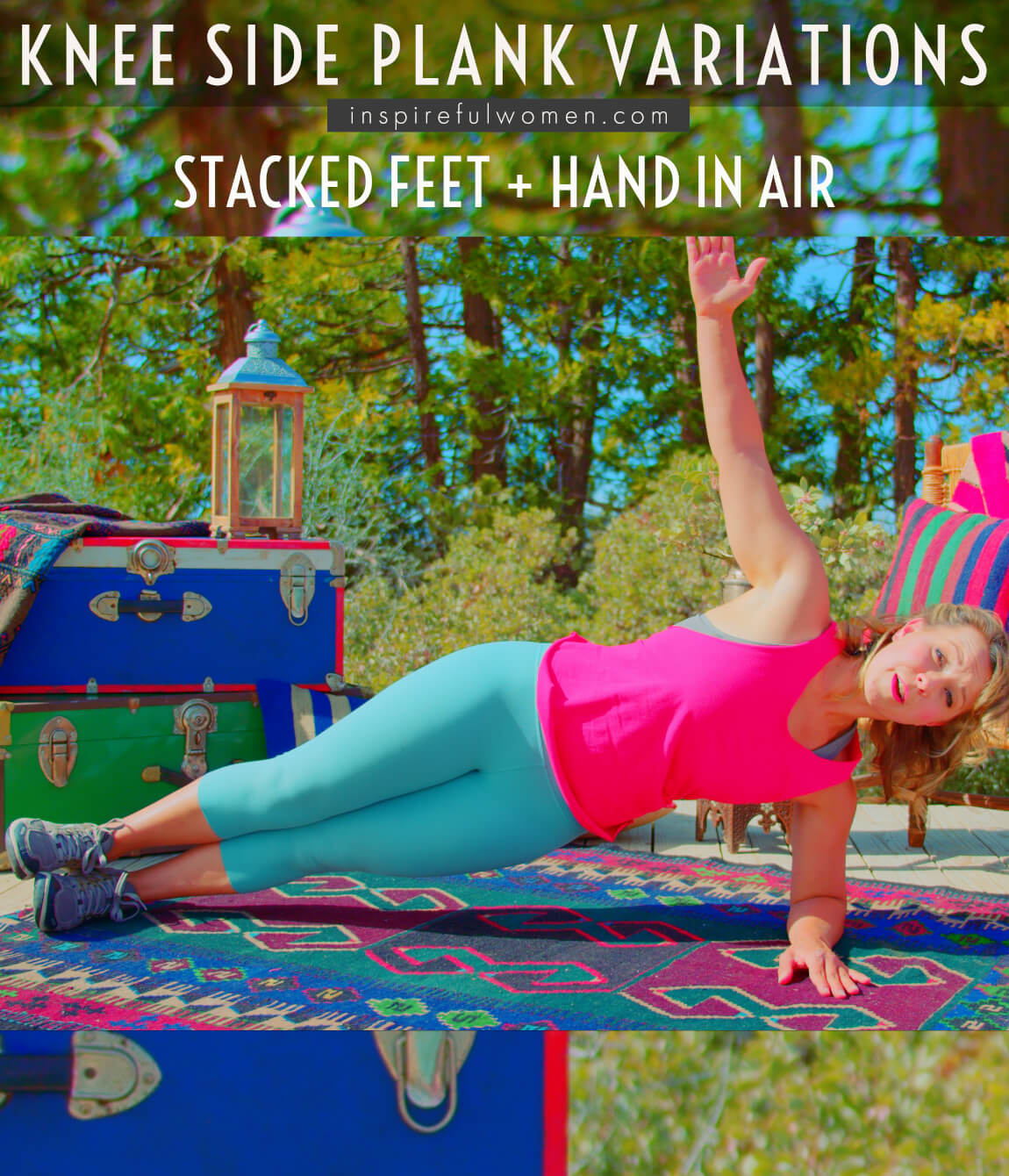
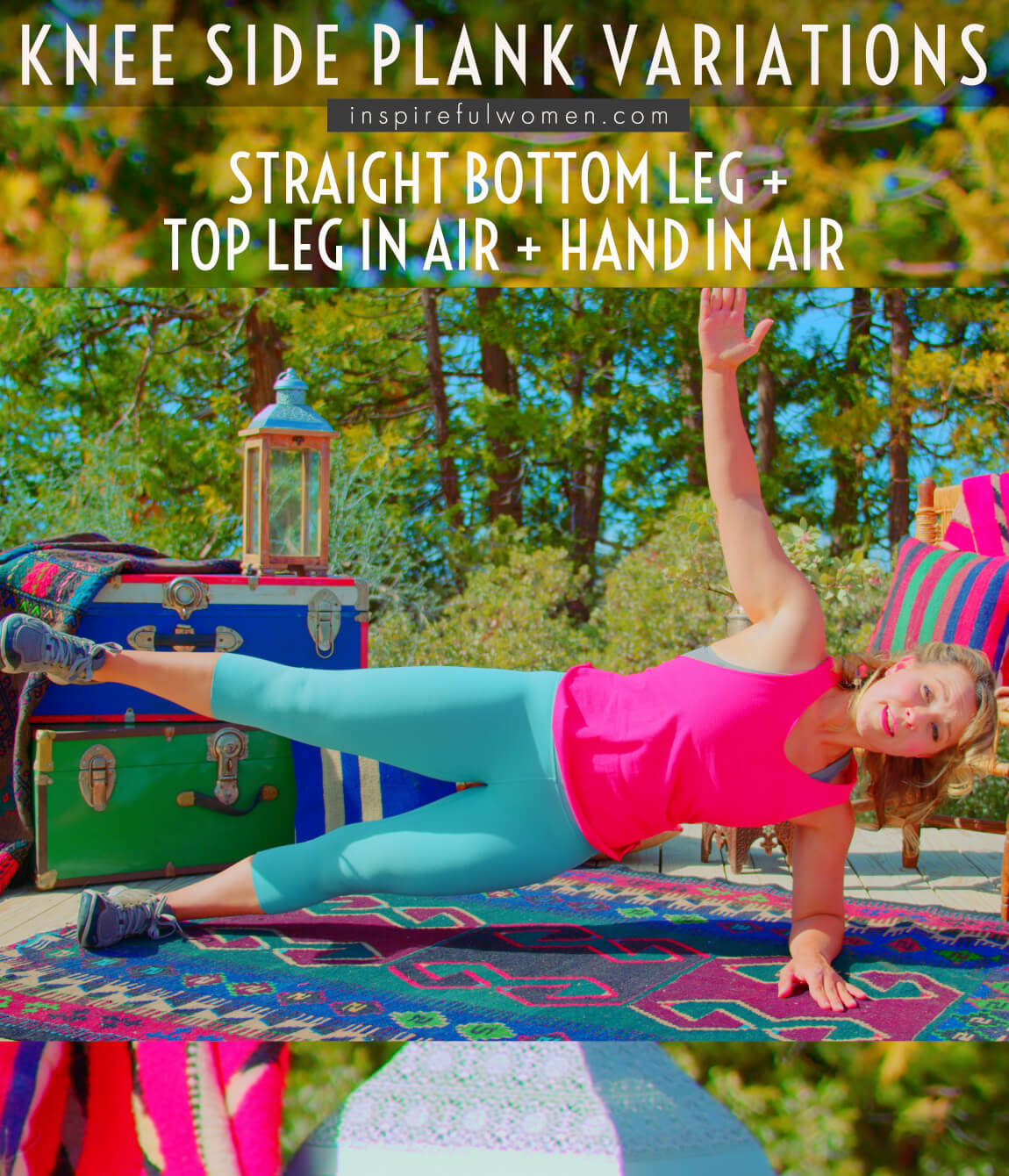
SCIENCY STUFF
ALLLL MUSCLES & WHEN
ALL MUSCLES WORKING & WHEN DURING THE Side Plank on Knees & Elbow
The muscles of the upper back, shoulder blade, and arm will work to hold the body still as it is pushed up into a side plank position.
The knees and arms serve as the two weight-bearing points. In this position, the hips rest on the floor. The latissimus dorsi pulls the shoulder blade in and back to activate the lats to stabilize the low back. In order to lift the hips up, the gluteus max muscles on the side of the body closest to the floor contract concentrically to push up to the side plank position. The external and internal obliques and quadratus lumborum are the most active core stabilizers working as you lift the pelvis up into the side plank position.
All of the core muscles (internal and external obliques, quadratus lumborum, psoas major, rectus abdominis, erector spinae, multifidi, transverse abdominis) will contribute isometrically to stabilize the torso in the side plank position.
PIN IT FOR LATER!
